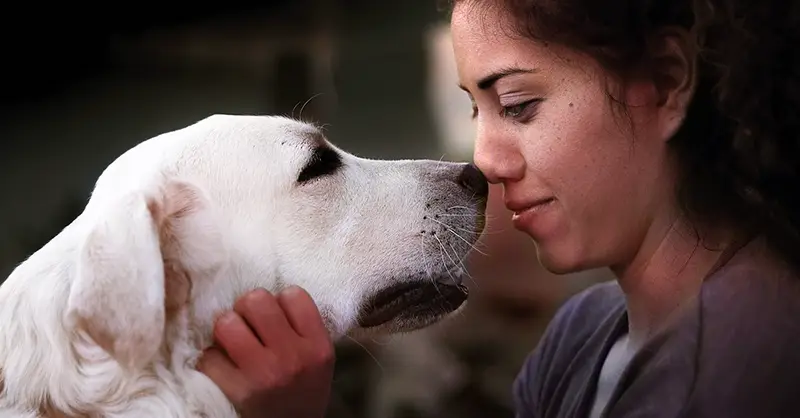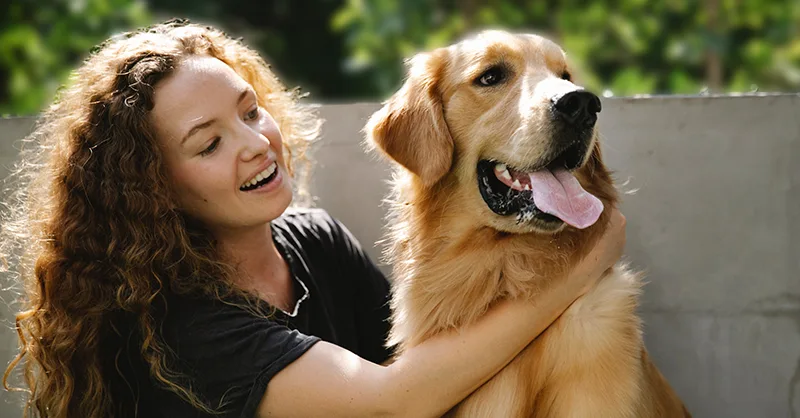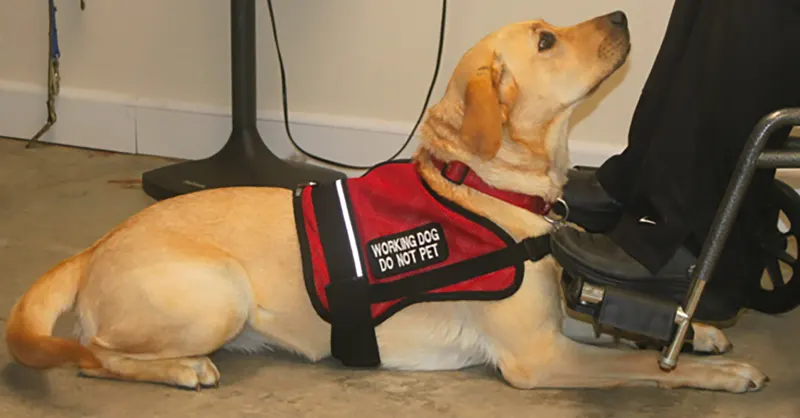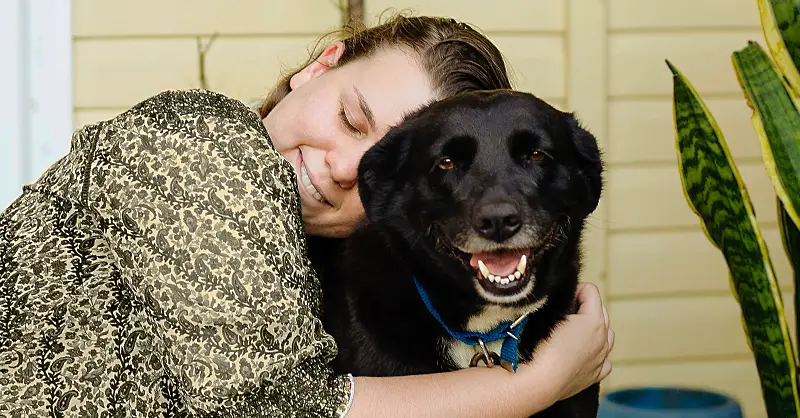Archive for the ‘Psychiatric Service Dog’ Category
An emotional support animal (ESA) can help manage your emotional or mental health condition. They provide comfort and affection when you need it the most. But an ESA can’t come with you into “no pets allowed” areas — except where you live — and airlines no longer allow emotional support animals to fly as pets. A psychiatric service dog (PSD), however, can do all the above and more. If you’re looking at your emotional support animal and wondering if it is possible to make it a psychiatric service dog, here’s what you need to know.
Emotional Support Animal versus Psychiatric Service AnimalAn emotional support animal is an important part of dealing with a person’s emotional or mental health condition. An ESA owner possesses supporting documentation — an ESA letter — from a licensed mental health professional indicating the individual’s needs an ESA for their mental health. An ESA does not require any formal training; it just needs to offer comfort to its owner in times of need.
An ESA is safeguarded by federal laws, particularly the Fair Housing Act (FHA), enabling ESAs to live with their handlers, even in housing with policies prohibiting pets. However, an ESA can’t accompany their handler outside the home into places that don’t allow pets.
On the other hand, a psychiatric service dog receives extensive training to perform specific tasks for its handler. Unlike an ESA, a PSD may accompany its owner wherever the public is allowed. These areas include movie theaters, parks, and shopping malls. Federal laws such as the Americans with Disabilities Act and the Air Carrier Access Act enable a PSD to reside and travel with their handler, even in instances where pets aren’t typically allowed.
Can an Emotional Support Animal become a Psychiatric Service Dog?It depends. First, only a canine qualifies as a psychiatric service dog. As cute, cuddly, and warm as a hamster, cat, or rabbit is as an ESA, they cannot qualify as a PSD. If your dog is an ESA, it may be possible to qualify for a PSD but it requires significant effort.
Qualifying Your ESA Dog to Become a PSDFirst, evaluate your situation. Are there any essential tasks you need a service dog to perform for you? How could your condition or quality of life improve if this task were done for you? Is this task something your emotional support dog could be trained to do? Is the task needed to assist with your mental health disability?
Then, evaluate your dog. Your dog might be excellent at giving affection and playing catch, but is your emotional support dog eager to learn and easy to train? Can it readily follow commands, be friendly with strangers, and be tolerant of other animals? All service dogs must be on their best behavior, especially in public areas, and not every dog has the capacity to maintain the required composure or perform complicated service dog jobs. Make an honest assessment of your needs and your emotional support dog and decide if it’s up for the task of becoming a psychiatric service dog.
Train Your DogThe primary factor that sets a psychiatric service dog apart from an emotional support animal is the service dog training regarding your emotional or mental health disability. Most service dogs go through months — sometimes years — of daily training to become safe and effective service dogs. For your ESA to qualify as a psychiatric service animal, it must undergo the same training and perform its assigned service dog job.
In addition to training your dog to perform its tasks, a service dog must also have public access training. Public access training ensures that your dog will exhibit the behavior it needs to be a service dog. Because service dogs are welcome to follow their handlers into public areas, they must maintain safe and controlled behavior. Despite performing its service tasks well, if the dog exhibits aggressive or disruptive behavior, a service dog may be asked to leave the area. A service dog can’t do its job if it’s not safe in public. Public access training teaches dogs to exhibit calm behavior, even when faced with crowds, other dogs, noises, or busy streets.
For an emotional support animal to qualify as a psychiatric service dog it must undergo strict task-based and public access training. Obtain a Psychiatric Service Dog LetterA psychiatric service dog letter is authored and endorsed by a licensed healthcare professional and addresses whether a person has a qualifying disability for the purposes of a owning a psychiatric service dog. A PSD letter gives owners peace of mind and documentation regarding their mental health disability. Other optional steps for fully qualified PSD owners include obtaining ID cards, registrations, certificates and other service dog accessories.
Having a Psychiatric Service DogOnce your ESA fully finishes training to become a psychiatric service dog, your new psychiatric service dog can accompany you anywhere the public can go, including areas where pets aren’t allowed.
You’re probably familiar with service dogs that assist people with physical challenges, like guide dogs for people with vision impairments. They’re easy to spot because their handlers typically have noticeable disabilities. However, some service animals work with people who have invisible disabilities. One example is a psychiatric assistance dog. You might wonder, “What’s a psychiatric assistance dog?”, and “Who can get a psychiatric assistance dog?” We’ll answer these and other questions for you below.
What is a Psychiatric Assistance Dog?Some disabilities are readily identifiable, as in the case of someone with a wheelchair or an amputee. Others, however, have disabilities or illnesses that aren’t visible from the outside. Psychiatric conditions, for example, are a type of invisible disability. Rather than having an obvious disability, psychiatric disabilities aren’t immediately apparent. Psychiatric assistance dogs — also known as psychiatric service dog (PSD) — are as vital as service dogs for amputees or the vision impaired; the difference is the disability they assist with isn’t readily apparent.
A psychiatric assistance dog performs tasks that their handler can’t do for themselves. Here are a few functions that a psychiatric assistance dog may be trained to perform:
Navigate through crowds to find a safe area in times of psychological distress. Act as a buffer between their handler and people or places that are potentially upsetting. Retrieve medication from a location not accessible by their handler. Search rooms before their handler’s entry, typically performed for people with post-traumatic stress disorder (PTSD). Prompt their handler to perform routine activities of daily living, like grooming or eating. Interrupt and redirect a handler who has obsessive-compulsive or self-harm behaviors. Provide tactile stimulation or pressure therapy for people who suffer from anxiety or PTSD. What Conditions Qualify for a Psychiatric Assistance Dog?Any mental disability or emotional disorder may qualify for a psychiatric assistance dog, as long as there is a task that the animal can perform for its handler. However, the job must be
a necessity for safety or day-to-day functioning, directly related to the disability, and not something the handler would otherwise be able to do for themselves.The following are a few examples of conditions that a psychiatric assistance dog could assist with:
Clinical Depression Anxiety Phobias Bipolar Disorder Obsessive-Compulsive Disorder PTSD Schizophrenia Panic Attacks Autism Any individual with a mental disability or emotional disorder may qualify for a psychiatric assistance dog. Is a Psychiatric Assistance Dog the same as a Therapy Dog or Emotional Support Animal?The short answer is “no.” Although therapy dogs and emotional support animals do help people and provide comfort, they don’t receive service dog training. In contrast, psychiatric assistance dogs receive extensive training to perform a specific task. They also pass a public access test to act appropriately in public areas and are exceptionally well-behaved. Although PSDs are typically dogs, they are not like regular pets; they perform an essential function for which they undergo months’ worth of training.
More importantly, psychiatric assistance dogs are protected under the Americans with Disabilities Act (ADA) and can accompany their handler almost anywhere. PSDs can enter areas where pets, therapy dogs, and emotional support animals are not allowed. Because service dogs are vital to their handler’s well-being, according to federal laws, they are also allowed to:
Live with their handlers in “no pets allowed” housing areas. Enter restaurants, hospitals, or theaters where other animals are prevented from entering. Fly with their handlers in the cabin of an airplane under the Air Carrier Access Act. Can I Get a Psychiatric Assistance Dog?First and foremost, you must have a diagnosable psychiatric condition if you would like a psychiatric assistance dog. Second, you must have one or more vital tasks in mind that a PSD can accomplish for you. Speak with a licensed mental health professional or physician to see if a psychiatric assistance dog could improve your quality of life and work for you.
Do you already have a dog that you’d like to train? Not all dogs are fit to be service dogs. Your dog should be eager to learn and respond to commands readily. Dogs that are anxious or fearful don’t typically perform well as service animals.
Can I Care for a Service Animal?The last question requires an honest answer from yourself. You and your mental healthcare provider may want to discuss your ability to care for psychiatric assistance dogs. Despite their intelligence and training, a PSD still needs daily feedings, grooming, and routine veterinary care. It’s important to determine whether the time and financial costs of a service animal is not beyond what you can provide.
Take good care of a psychiatric assistance dog so it can take good care of you.
See if your mental or emotional disability qualifies for a psychiatric assistance dog. Get an PSD Letter assessment from a licensed medical professional.The Texas state motto is one simple and beautiful word — friendship. And there’s no better friendship than the one from man’s best friend. Dogs provide humans with companionship and affection. Service dogs, however, can also save our lives.
A psychiatric service dog (PSD) is a particular type of service dog that assists people who have a mental or emotional disability. Let’s discuss a few ways to get a psychiatric service dog in Texas.
What is a Psychiatric Service Dog?A service dog receives extensive training to perform one or more specific tasks for someone with a disability. The task must relate directly to the disability and be something their handler would be unable to do for themselves. A service dog is also trained to maintain safe behavior in public. Unlike therapy dogs and emotional support animals (ESA), service dogs are highly trained.
Psychiatric service dogs (PSD) receive training to perform tasks that help people with mental or emotional disorders. For example, a PSD trained to assist someone with social anxiety or Post Traumatic Stress Disorder may act as a physical barrier in social situations. These dogs may block strangers from coming too close, preventing a panic attack. Other PSDs may perform deep pressure therapy to reduce anxiety and stress.
Federal and State Laws Protect Service DogsAll service dogs, including psychiatric service dogs, are covered under the Americans with Disabilities Act (ADA). Under the ADA, service dogs may accompany their handlers into areas the public is typically allowed, even in places where no pets can go. For example, a service dog may enter a movie theatre or grocery store — places other animals can’t enter.
Other federal laws which apply to service dogs are the Fair Housing Act (FHA) and Air Carrier Access Act (ACAA). Under the FHA, landlords and housing managers must allow all service animals into their rentals. Pet fees do not apply to service animals because they aren’t considered pets. The ACAA enables people with disabilities to travel with their service dogs without restrictions typically reserved for pets.
Texas state laws regarding service animals align with federal regulations. In addition, Texas state laws also have the following rules:
There is a criminal penalty punishable by a fine of $300 and 30 hours of community service for denying access to a person with a disability due to a service animal. Employees have up to ten days of paid leave for an assistance dog training program. Public facilities and transportation carriers are required to allow a person with a qualifying disability, a service dog trainer, and a service dog to use their services. Getting a Service Dog in TexasBefore starting the search for psychiatric service dogs, you may choose to consult with your physician or licensed mental healthcare provider. Assess your needs and determine how a service dog could address them.
You can obtain a service dog by:
Purchasing a fully-trained service dog. Buy or adopt a dog, then train the service dog on your own. Buy or adopt a dog, then outsource the more complex training. Reserve basic skills training to do on your own. Buy or adopt a dog, but outsource all the training. Finding and Training Your Psychiatric Service Dog in TexasIf you’re looking to adopt a potential psychiatric service dog, these Texas establishments may have the ideal dog for you.
Operation KindnessEven after 45 years in operation, Operation Kindness in Carrollton, Texas, remains dedicated to rescuing homeless animals. In addition to pet adoptions, they also have a pet food pantry and offer a surrender prevention program. Their extensive Foster Team ensures that animals are rehabilitated and socialized.
Straight Outta TexasStraight Outta Texas rescues homeless animals and sends them to loving forever homes. Their fosters encourage sociability, but some dogs may also need basic obedience training. Straight Outta Texas offers a variety of dogs and also allows for out-of-state adoptions.
Give Us PawsGive Us Paws is found in Houston and offers free or discounted training for veterans and civilians with PTSD and other disabilities. Their training program consists of eight to twelve months of group and one-on-one service dog training. The one-on-one training is disability-specific and customizable.
Dog Alliance AcademyThe Dog Alliance Academy provides free service dogs for qualified veterans. What’s more, they offer paid service dogs for civilians. The Dog Alliance Academy also hosts a variety of programs like in-person training sessions, trained therapy dogs, and support for veterans with PTSD and children with special needs.
Your Psychiatric Service Dog in TexasTexas offers numerous rescue centers and service dog training programs. Finding and training your service dog may sound overwhelming, but it’s well worth it. You’ll find that a psychiatric service dog in Texas can become your most meaningful friendship and make your life easier.







